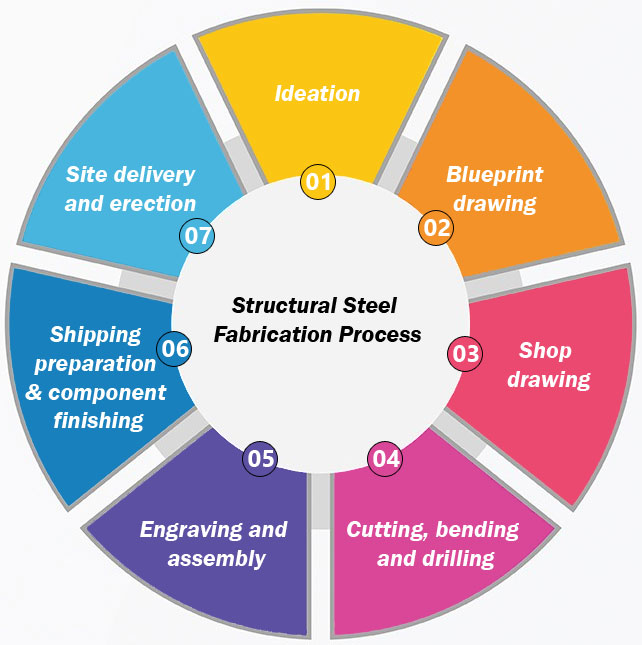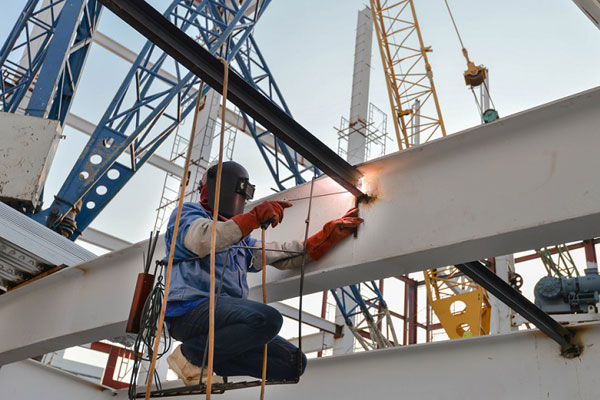Structural steel fabrication is the process of bending, cutting, and modelling steel to form a structure. For structural steel fabrication pieces of steel are put together to make different structures that are usually of predefined sizes and shapes. It is a complex process that requires specialized knowledge, skills, and resources to complete successfully.
Advantages of structural steel fabrication
- Steel is highly durable, it is corrosion resistant and tensile. The strength of steel is higher than its density which makes it an excellent choice for construction.
- Structural steel usually arrives in the pre-fabrication phase and is fabricated on-site. Pre-fabrications reduce how much work needs to be done on-site, fast-tracking projects.
- Structural steel is cost-effective when compared to other metals such as copper, silver, gold, aluminum and magnesium.
- The components of structural steel are easy to install after fabrication, so with increased efficiency in the installation process, a considerable amount of money and time is saved.
- Steel metallurgical properties enable it to be fabricated into any shape and size with ease. Steel structures are fabricated by welding or bolting them together.
- Structural steel is coated with a fire resistant material which makes it highly resistant to fire. It is water resistant. It can withstand storms, and earthquakes if built properly.
- Structural steel components are built off-site, thereby reducing the chances of any accidents on site. It is resistant to molds and termites which makes it a good choice.
- Structural steel is easily recyclable and is, therefore, an environment-friendly option for metal fabricators.
- Structural steel is a practical choice for a wide range of designs from simple to complex.
- Steel provides significant cost savings, ROI for structural steel is closely associated with its strength and reliability.
Structural steel fabrication process
The structural fabrication process involves multiple stages. This process requires skilled and experienced technicians who can take raw components and transform them into quality products. Each of the processes is discussed below.
Stage 1 – Ideation, blueprint and shop drawings
Ideation stage can be creative as per the requirement of using steel components. Here the fabricator can make any structural steel products that you are looking for. Blueprint: – Drawing is created through different software which undertakes requirements, code compliances and specifications. Conversion of Blueprint into Shop Drawings. To complete the processing of steel it will be converted into shop drawings that will adhere to logistics of the project including deadlines and budget.
Structural steel fabrication involves cutting, bending and welding steel to make a structure. Unlike various types of welding in which steel alloy is repaired or strengthened, steel fabrication is when pieces of steel are put together to form different structures that are usually of predefined sizes and shapes. This process requires skilled and experienced technicians who can take raw components and transform them into marketable products hence not everyone is capable of fabricating structural steel.
Stage 2 – Cutting, bending and drilling
Cutting is the first part of structural steel fabrication. High-grade steel needs to be cut by cropping or sawing using different tools like laser cutting steel, plasma torches, or water jets etc. This is usually done in a closed manufacturing factory and some safety measures are needed to be taken for this process. The methods typically employed are sawing (cold sawing or band sawing), burning and shearing. Shearing generally is limited to miscellaneous structural steel parts. It is not used on larger structural elements, because the force required and the resulting cut quality limit economic and practical feasibility.
Bending comes next. The bending of the structural alloy for which there is specialized machinery; there are still many fabricators who prefer to do it manually by hammering the alloy as well. It also depends on the type of project as, if there is a requirement of a repetitive bending of multiple steels, then using machinery will be much more feasible. ! There are five typical methods of bending in the industry: rolling, incremental bending, hot bending, rotary-draw bending, and induction bending. Each method has its advantages. The principal advantage of curved structural steel is its aesthetic appeal. It allows architects and designers to express a variety of forms and makes exposed steelwork an attractive solution.
Third comes welding. It involves creating a variety of welds with different component materials to create, fabricate, and erect welded structures. Seel sections are assembled here to make complete structures. After cutting and forming of steel components are done, then the welding process begins to assemble it into a complete structure. Structural welding has its own set of codes, blueprints, and types of weld joints. It is used to create metal frameworks for buildings, bridges, vehicles, and a variety of other complex structures. Structural welding is also used to cut and repair beams, columns, and girders.
The Regular Steel fabrication elements are Plate Metal, Formed and expanded metal, Welding Wire/ Rod Casting.
Stage 3 – Engraving and assembly
All the steel items will be etched with part number and plate location that convert it into a final assembled part on site that is fast, easy and accurate. The component assembly is an integral part of the steel fabrication process. It is required to attach fixtures and fittings to prepare connections for installation on site. Steel sections are assembled here to make complete structures. Once assembling of components is finished, it will be checked if it meets the specification or not. Fabricators sometimes create custom parts that are ideal when you need components to fit a structure or product used in your project.
Stage 4 – Shipping preparation and component finishing
In this stage all the assembled components are packed to make the project erection at site easy. Once the steel is completely assembled into a shape that we were looking for it is then processed for applying the coating to protect it against corrosion and fire.
Stage 5 – Site delivery and erection
The final shipment of the components is done in this stage. The project is then erected on the site for construction purposes.

Application of structural steel fabrication in construction
Structural steel is a high quality material and many applications depend solely on it for its construction. Its application area include;
- High-rise buildings
- Industrial Buildings
- Residential Buildings
- Parking Garages
- Bridges

